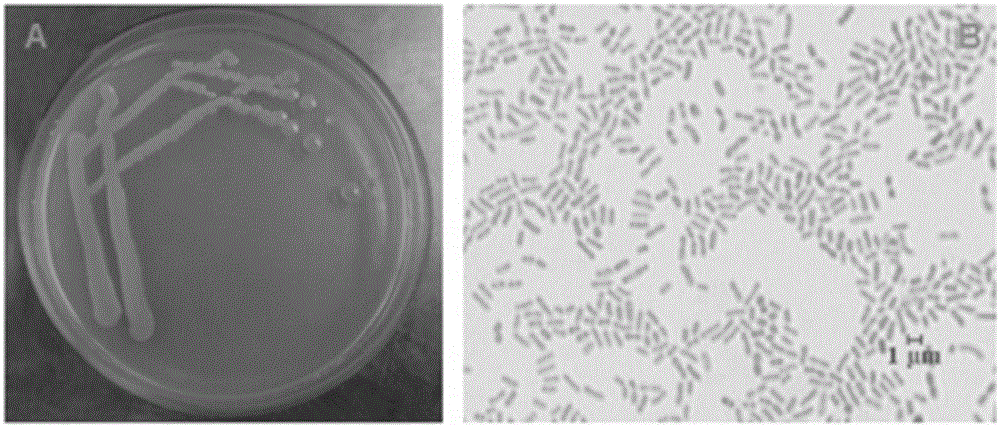Achromobacter for heavy metal cadmium pollution treatment and application thereof
A colorless bacteria and heavy metal technology, applied in the restoration of polluted soil, water pollutants, biological water/sewage treatment, etc., can solve problems such as complex transformation behavior, and achieve the effect of reducing biological toxicity and intake.
- Summary
- Abstract
- Description
- Claims
- Application Information
AI Technical Summary
Problems solved by technology
Method used
Image
Examples
Embodiment 1
[0016] The isolation and identification of embodiment 1 Achromobacter H380
[0017] The soil polluted by heavy metals from the Daye mining area in Hubei was used as the screening soil. The specific screening scheme is as follows:
[0018] (1) Isolation of cadmium-resistant bacteria H380
[0019] A. Weigh 10g of cadmium-contaminated soil in 90mL of sterile saline, oscillate and shake on a constant temperature shaker at 28°C, and after standing still, take the supernatant for cultivation;
[0020] B, the supernatant is transferred to sterile 0.5 times LB (containing 200mg / L of Cd 2+ ), cultured in a constant temperature shaker at 28°C for about 10 days, and then inoculated with 10% inoculum to a concentration of 300mg / LCd 2+ 0.5 times of LB medium, then cultured in a constant temperature shaker at 28°C for about 10 days, and then transferred to a medium containing 400mg / LCd in the same way again 2+ Cultured in 0.5 times LB medium for about 10 days. Finally, take 0.2ml of the...
Embodiment 2
[0027] The environmental adaptation characteristic of embodiment 2 Achromobacter H380
[0028] The applicant tested the tolerance of Achromobacter H380 to various heavy metals and antibiotic resistance.
[0029] Inoculate H380 strain into fresh 0.5 times LB medium to activate overnight, then inoculate 1% (v / v) inoculum into fresh 0.5 times LB medium, and cultivate to OD in a constant temperature shaker at 28°C 600 = about 0.5; then inoculate them into M9 medium containing different cadmium ion concentrations and 0.5 times LB medium with 1% (v / v) inoculation amount, and then put them into a constant temperature shaker at 28°C for 3 days, and then take Centrifuge 2ml of the culture at 6000rpm for 5 minutes, add 2ml of sterile saline to suspend, and measure the OD 600 absorbance value. At the same time, take 2ml of the culture from the culture, centrifuge at 6000rpm for 5 minutes under sterile conditions, add 2ml of sterile normal saline to suspend, and then carry out gradient ...
Embodiment 3
[0038] Example 3: Adsorption capacity of Achromobacter H380 to cadmium
[0039] Further, the applicant tested the growth status of Achromobacter H380 and the ability to scavenge cadmium ions under different cadmium ion stress conditions.
[0040] Activate Achromobacter H380 bacterial strain according to the method for embodiment 2, then inoculate with 1% (v / v) inoculum ratio to contain different Cd 2+ 0.5 times the concentration of LB medium, 28 ° C, 180 rpm shaker culture. Then take 2ml of the culture at different times, centrifuge at 5000rpm at 4°C for 8min, discard the supernatant, suspend it with 2ml of sterile saline, and measure its OD 600 value. After culturing for 72 hours, take 10ml of the culture, centrifuge at 5000rpm at 4°C for 8min, take out the supernatant and send it to the Analysis and Testing Center for cadmium ion concentration analysis; at the same time, the precipitated part is still suspended in 10ml of sterile saline, and then measure its OD 600 value....
PUM
 Login to View More
Login to View More Abstract
Description
Claims
Application Information
 Login to View More
Login to View More - R&D
- Intellectual Property
- Life Sciences
- Materials
- Tech Scout
- Unparalleled Data Quality
- Higher Quality Content
- 60% Fewer Hallucinations
Browse by: Latest US Patents, China's latest patents, Technical Efficacy Thesaurus, Application Domain, Technology Topic, Popular Technical Reports.
© 2025 PatSnap. All rights reserved.Legal|Privacy policy|Modern Slavery Act Transparency Statement|Sitemap|About US| Contact US: help@patsnap.com



